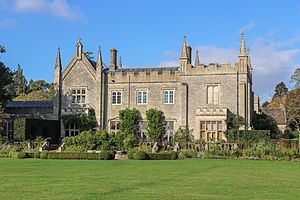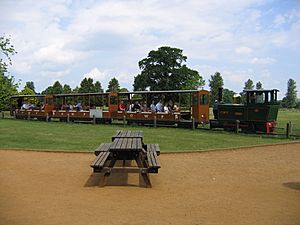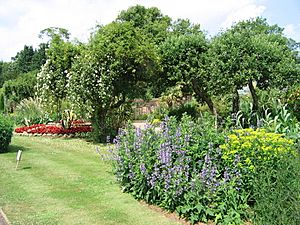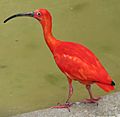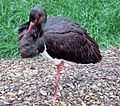Cotswold Wildlife Park facts for kids
 |
|
| Date opened | 1970 |
|---|---|
| Location | nr Burford, Oxfordshire, England |
| Land area | Wildlife Park: 48 acres (0.194 km2), Gardens: 160 acres (0.647 km2) |
| Coordinates | 51°46′25″N 1°39′15″W / 51.77361°N 1.65417°W |
| No. of species | 260+ (2012) |
| Major exhibits | Walled Garden, 'Madagascar', Woodland Walk, Reptile House, Bat House, Insect House, Tropical House, train, Adventure Playground. |
The Cotswold Wildlife Park & Gardens is a fun place to visit in Oxfordshire, England. It's home to over 260 different kinds of animals! The park covers 160 acres of beautiful gardens and land. You can find it about 2 miles south of Burford. In 2012, about 350,000 people came to explore the park.
Contents
Meet the Animals: Exciting Exhibits
The park has many special areas where you can see animals from all over the world.
Walled Garden: Birds, Sloths, and More
The Walled Garden is a cool spot with lots of bird houses. You can see Humboldt penguins here, and even watch them get fed and hear a talk every day at 11 am and 3 pm. There's also a Tropical House filled with amazing plants and birds like great blue turacos. Look closely for sloths moving slowly through the trees!
Other animals in this garden include playful meerkats, yellow mongooses, and prairie dogs. You might also spot cute Oriental small-clawed otters. Plus, there are small monkeys like squirrel monkeys and tiny pygmy marmosets.
Madagascar: A Walk with Lemurs
Opened in 2008, the 'Madagascar' exhibit is a special walk-through area. It teaches visitors about the challenges faced by endangered lemurs. You can see different types of lemurs like ring-tailed lemurs and collared lemurs.
The park has been very successful in breeding lemurs. The ring-tailed lemurs have had babies regularly since 2009! Don't miss the lemur feeding and talk at noon each day.
Woodland Walk: South American Wonders
The Woodland Walk takes you on a journey to South America. Here, you'll find larger animals like Brazilian tapirs and capybaras, which are the world's largest rodents. You might also see giant anteaters with their long snouts.
Other animals along this walk include Canadian timber wolves and parma wallabies. The walk starts with a bridge over a lake. This lake is home to many different ducks and bright pink Chilean flamingos.
Large Mammals and Big Cats
In the park's open areas, you can see some really big animals. There are tall giraffes, speedy Chapman's zebras, and huge ostriches. You'll also find white rhinoceros and Bactrian camels here.
Close by are the enclosures for the park's big cats. You can see beautiful clouded leopards and majestic Asiatic lions.
Reptile House, Bat House, and Insect House
The Reptile House is full of fascinating creatures. You can see black mambas, crocodile monitors, and colorful poison dart frogs. Look out for the very large reticulated pythons and anacondas! The park even helped hatch Morelet's crocodile babies in 2007.
The Insect House has amazing leaf-cutter ants, scorpions, and tarantulas. In the Bat House, you can watch Seba's short-tailed bats and Egyptian fruit bats flying around. Nearby, you'll find white-handed gibbons and siamangs.
Around the Manor House
Near the old manor house, under a 600-year-old oak tree, live the cute red pandas. In front of the manor house, next to the rhino area, are the giant Aldabra giant tortoises. Behind the house, you'll find a fun adventure playground, picnic spots, and a restaurant.
By the Railway Station
Around the railway station, you can see different kinds of owls and birds of prey. These include the great grey owl and the snowy owl. Close by is an enclosure for black-and-white colobus monkeys.
Next to the station entrance, you'll find the wolverines. In 2012, the park's wolverines had the first-ever cubs born in captivity in the UK! The park is the only place in Europe to have successfully bred wolverines.
History of the Park
The main building at the park is called Bradwell Grove Manor House. It was built in 1804. The design was inspired by a famous house called Strawberry Hill. This new house replaced an older one from the 1600s. The owner at the time, William Hervey, also planted many trees. You can still see some of them, including a huge wellingtonia tree that is over 40 meters tall!
In 1923, the estate was bought by Colonel Heyworth-Savage. After he passed away, his grandson, John Heyworth, inherited it. John Heyworth was born in the manor house in 1925. For twenty years, the house was rented out to a hospital board.
Then, in 1969, John Heyworth decided to open the gardens to the public. In 1970, the house became the center of the new Wildlife Park. John Heyworth passed away in 2012. Now, his son, Reggie Heyworth, manages the park.
The Walled Garden used to be a kitchen garden where fruits and delicate plants grew. The Tropical House now stands where three greenhouses once were. These greenhouses grew flowers like carnations and fruits like figs and nectarines. There was even a cricket pitch and tennis courts where the car park is now. Long ago, there was even a nine-hole golf course!
Today, the manor house is used for many things. The old dining room is now a brass-rubbing center. The drawing room is used for meetings and exhibitions. The library is a bar area. Even the cellars are used to help some reptiles hibernate! The old stables are now the reptile and bat houses, classrooms, and offices. The billiard table from the old billiard room was even turned into part of the waterfall in the penguin enclosure!
Other Fun Things to See
Ride the Park Train
The park has a fun narrow gauge train that takes you on a ride. The track is almost a mile long and goes all around the park. The train station is located near the owl aviaries and the Walled Garden.
The railway was first built in 1974. The full circuit and a new station were completed in 2007. The train is named Bella to remember one of the park's first white rhinos.
Explore the Gardens
The park is famous for its amazing plants, especially in the Walled Garden. Here, you can see bananas and bright cannas growing. There are also huge Californian redwood trees, tall tree ferns, and giant giant rhubarb plants.
The gardens are designed to look beautiful alongside the exotic animals. The South Terrace has an old-fashioned feel. The West Terrace, near the restaurant, has a more modern look. In May, the front of the restaurant is covered in lovely wisteria flowers. There's also a 'Winter Garden' that looks interesting even in the colder months.
The park loves bamboo and has over fifty different kinds! They even use rhino manure to help the bamboo grow. Around the rhino area, the plants look like the African plains. A huge cedar of Lebanon tree in the Adventure Playground now supports a children's tree house and slide.
Helping Animals: Conservation Efforts
The Cotswold Wildlife Park is very involved in helping endangered animals. As of 2006, the park helps protect 40 species through special programs. These include the European Studbook (ESB) and the European Endangered Species Programme (EEP).
The park keeps records for the red-crested turaco and Mount Omei babbler. They also help monitor species like the crested pigeon and blue-winged kookaburra. In 2015, the park was excited to announce that a second white rhinoceros had been born there!
Gallery
All photographs were taken in the park.
-
Bactrian camel (Camelus bactrianus)
-
Morelet's crocodile (Crocodylus moreletii)
-
White-naped crane (Grus vipio)
-
Scarlet ibis (Eudocimus ruber)
-
Southern lapwing (Vanellus chinensis)
-
Brown wood-owl (Strix leptogrammica)
-
Black stork (Ciconia nigra)
-
Tawny frogmouth (Podargus strigoides)


